SMD components (chip components) - These are electronic circuit components applied to a printed circuit board (motherboard of a computer, laptop, tablet, smartphone, hard disk, etc.) using surface mount technology (SMT). That is, all electronic elements that are "fixed" on the board in this way are called SMD components (surface-mounted device).
This type of installation is characterized by the fact that, in contrast to the older technology of through installation (when under electronic component: a transistor, a resistor, a capacitor is drilled a hole in a PCB), SMD components are much more compact on a printed circuit board. The components themselves are much smaller.
If you pay attention to the modern laptop motherboard, you can see that it is the SMD components that make up the bulk of the details on the board - there are a lot of them and they are located very closely (small colored squares and rectangles of gray, black colors), on both sides of the PCB. In the following figure, SMD components are marked in red.
The motherboard of the tablet or smartphone is made exclusively using SMT technology (surface mounting) and SMD elements, since there is no place and need for through installation.
The motherboards of desktop computers most often use both mounting technology. In the figure below, through-fitting elements are marked in green. The contacts of the components (electrolytic capacitors in this case) are inserted into special holes in the motherboard and soldered from the back side.
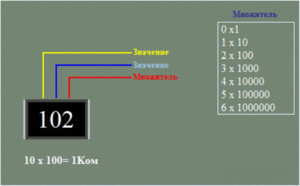
Advantages of SMD components and surface mounting
- Smaller SMD components compared with elements used in through-wiring;
- Significantly higher density of placement on the board;
- Higher density of tracks (connections) on PCB;
- Components can be located on both sides of the board;
- Small errors in SMT installation (soldering) are corrected automatically by the surface tension of the molten tin (lead);
- The best resistance to mechanical damage due to vibration;
- Lower resistance and inductance;
- There is no need to drill holes, including, as a result, a lower initial production cost (economic effect);
- More adapted to automated assembly. Some automated lines are capable of placing more than 136,000 components per hour;
- Many SMD components cost less than analogue for through installation;
- Suitable for devices with a very low profile (height). The printed circuit board can be used in a housing just a few millimeters thick.
disadvantages
- Higher requirements for the production base and equipment;
- Low maintainability and higher requirements for repair specialists;
- Not suitable for mounting connectors and connectors, especially when used in the case of frequent disconnections;
- Not suitable for use in equipment high power and experiencing high loads
Using materials: Surface-mount technology,
Modern radio equipment is based mainly on so-called chip components, these are chip resistors, capacitors, microcircuits, and so on. Outgoing radio components, which we are accustomed to soldering from old TVs and tape recorders and which amateur radio operators usually use to assemble their circuits and devices, are less and less used in modern radio equipment.
What are the advantages of using such chip elements? Let's see.
Advantages of this type of installation
First, the use of chip components significantly reduces the size of the finished printed circuit boards, their weight is reduced, as a result, this device will require a small compact body. So you can collect very compact and miniature devices. The use of chip elements makes saving a printed circuit board (glass fiber laminate), as well as ferric chloride to etch them, moreover, one does not have to waste time drilling holes, in any case, it takes not so much time and money.
Boards made in this way are easier to repair and easier to replace the radio elements on the board. You can make double-sided boards, and place elements on both sides of the board. Well, saving money, because the chip components are cheap, and taking them in bulk is very profitable.
To begin with, let's define the term surface mount, what does this mean? Surface mounting is a production technology of printed circuit boards, when radio components are placed on the side of printed tracks, for placing them on the board it is not necessary to drill holes, if briefly, this means "surface mounting". This technology is the most common today.
In addition to the advantages, there are of course also disadvantages. Boards assembled on chip components are afraid of bends and blows, since after that, the radio components, especially the resistors with capacitors, simply simply crack. Chip components do not tolerate overheating when soldering. From overheating, they often crack and microcracks appear. The defect does not manifest itself immediately, but only during the operation
Types and types of chip radio components
Resistors and capacitors
Chip components (resistors and capacitors) are primarily divided into standard sizes, there are 0402 - these are the smallest radio components, very small, such as used for example in cell phones, 0603 - also miniature, but slightly larger than the previous ones, 0805 - used for example in motherboard boards, the most running, then go 1008, 1206 and so on.
Resistors:
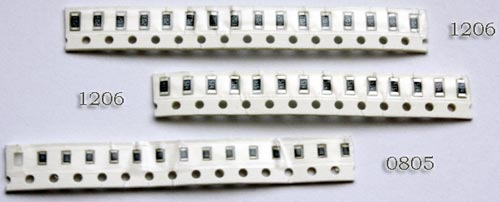
Capacitors:
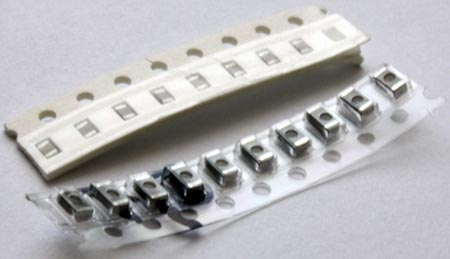
Below is a table with the dimensions of some elements:
- 1.0 × 0.5 mm
- 1.6 × 0.8 mm
- 2.0 × 1.25 mm
- 3.2 × 1.6 mm
- 4.5 × 3.2 mm
All chip resistors are designated coded markingAlthough the method of decrypting these codes is given, many still do not know how to decipher the values of these resistors, in this connection I have written the codes of some resistors, take a look at the table.
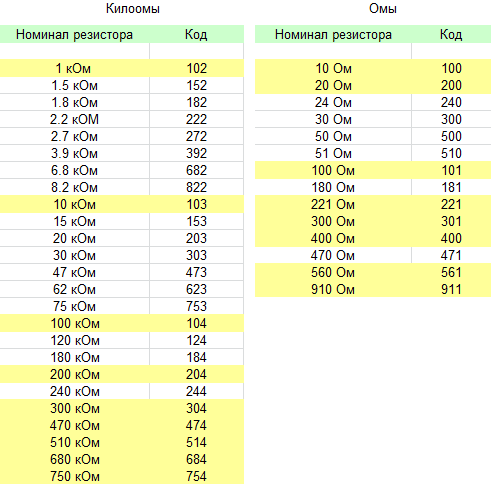
Note: In the table, the error: 221 "ohms" should be read as "220 ohms".
As for capacitors, they are not labeled or marked in any way, so when you buy them, ask the seller to sign tapes, otherwise you will need an accurate multimeter with the function of determining capacitances.
Transistors
Most radio amateurs use transistors of the SOT-23 type, I will not tell about the rest. The dimensions of these transistors are as follows: 3 × 1.75 × 1.3 mm.

As you can see, they are very small, you need to solder them very carefully and quickly. Below is the pinout of the findings of such transistors:

Pinout for most transistors in such a package is exactly like this, but there are exceptions, so before soldering the transistor, check the pinout of the pins by downloading the datasheet to it. Such transistors in most cases are denoted with one letter and 1 digit.
Diodes and zener diodes
Diodes, like resistors with capacitors, are of different sizes, larger diodes are indicated by a strip on one side - this is a cathode, but miniature diodes may differ in the labels and in the pinout. Such diodes are usually marked with 1-2 letters and 1 or 2 digits.
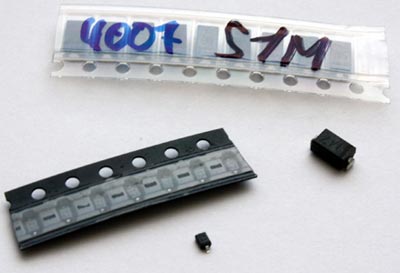

Zener diodes, as well as diodes, are indicated by a strip with the edge of the housing. By the way, because of their shape, they love to run away from the workplace, they are very nimble, and if they fall, you will not find it, so put them, for example, in the lid of a jar of rosin.
ICs and microcontrollers
Chips come in different housings, the main and frequently used types of housings are shown below in the photo. The most not good type of case is SSOP - the legs of these microcircuits are so close that it is almost impossible to solder without snot, all the time the nearest outputs stick together. Such microcircuits need to be soldered with a soldering iron with a very thin sting, and preferably with a blow dryer, if there is one, I painted the method of working with a hairdryer and soldering paste in this one.

The next type of case is TQFP, the photo shows a case with 32 legs (ATmega32 microcontroller), as you can see the case is square, and the legs are located on each side, the main drawback of such cases is that they are difficult to solder with a regular soldering iron, but you can. As for the other types of cases, it is much easier with them.
How and what to solder the chip components?
The chip of a radio component is best to solder with a soldering station with a stabilized temperature, but if there is none, then only a soldering iron remains, which must be switched on through the regulator! (without a regulator, most ordinary soldering irons have a temperature on the sting of 350-400 * C). Soldering temperature should be around 240-280 * C. For example, when working with lead-free solders having a melting point of 217-227 * C, the temperature of the tip of the soldering iron should be 280-300 ° C. During the soldering process, it is necessary to avoid excessive heat of the tip and excessive soldering time. The tip of the soldering iron should be sharply sharpened, in the form of a cone or a flat screwdriver.
Printed tracks on the board must be tinned and coated with alcohol-rosin flux. When soldering, the chip component is conveniently supported with tweezers or a fingernail, it is necessary to solder quickly, no more than 0.5-1.5 sec. First, solder one component pin, then remove the tweezers and solder the second pin. The chips need to be very precisely combined, then the extreme ends are sealed and checked again, whether all the outputs fall exactly on the tracks, and then the remaining outputs of the chip are sealed.
If the adjacent pins stick together when soldering chips, use a toothpick, put it between the pins of the microcircuit and then touch one of the pins with a soldering iron, while using more flux. You can go the other way, remove the screen from the shielded wire and collect the solder from the terminals of the microcircuit.
Some photos from personal archive

Conclusion
Surface mounting saves money and makes very compact, miniature devices. With all its drawbacks, which take place, the net effect undoubtedly indicates the prospects and relevance of this technology.
Resistors ... How much important is contained in this word for those who are fond of electronics or constantly working with it. However, for complete immersion in the world of electronics, it is necessary to at least superficially know and be able to determine the marking of chip resistors.
The abbreviation “SMD” stands for Surface Mounted Devices, which means “ surface mounted device". And this is true - resistors are installed above the surface on special mounts. These devices are mounted on printed circuit boards.
One of the significant advantages of smd-chips is their small size. On one PCB can be easily place dozens (if not hundreds) of similar products. Also due to high quality and low cost, resistors have gained extraordinary popularity in the electronics market.
Due to the constant progress, there are all new models of resistor chips, marking and characteristics of which are constantly changing. In total, there are 3 types of products in this market:
- Made in the Soviet period (now significantly losing popularity).
- Modern models.
- SMD Resistors.
In this article we will focus on the labeling of the latter type, since it is most interesting.
Principles of labeling
All SMD chips are labeled differently. The fact is that each product has its own size and tolerance value. Accordingly, in order to avoid confusion, the manufacturers decided to allocate 3 main groups for labeling:
- Products denoted by 3 digits.
- Models with 4 digits in the marking.
- Devices with 2 digits and one letter.
Each of these types should be considered in more detail.
The first group includes products (numbers 103, 513, etc.) with a tolerance of 2%, 5% or 10%. Under the first two digits of the mantissa, and the latter indicates the exponent 10. The last value is necessary to calculate the resistor nominal value (measured in Ohms). Also, in some models there is the letter "R", which denotes a decimal point.
 To the second group, it was decided to include models with a size of 0805 and higher, as well as having a tolerance of 1%. The principle is similar to the first group of resistors: the first 3 digits denote the mantissa, and the fourth denotes the power of the base 10. In addition, here, just as in the previous type, the last number implies the model rating (in ohms), and the letter R denotes decimal point. It is worth mentioning that devices with a size of 0402 are not marked.
To the second group, it was decided to include models with a size of 0805 and higher, as well as having a tolerance of 1%. The principle is similar to the first group of resistors: the first 3 digits denote the mantissa, and the fourth denotes the power of the base 10. In addition, here, just as in the previous type, the last number implies the model rating (in ohms), and the letter R denotes decimal point. It is worth mentioning that devices with a size of 0402 are not marked.
Finally, in the last group are smd chips with a size of 0603 and a tolerance level of 1%. The numbers indicate the code in table EIA-96 (see below), and the letter indicates the value of the multiplier:
- A - number 10 to the zero degree
- B - base 10 with degree 1
- C is the number 10 to the power of 2
- D = 10 3
- E = 10 4
- F = 10 5
- R = 10 -1
- S = 10 -2
Marking Interpretation
To install or work with SMD resistor, you need to know and be able to decipher the numbers and letters. This process can be divided into 2 types.
Plain decryption
As mentioned above, in the manufacture of smd resistors, unbreakable marking rules apply. They are designed to the buyer could easily identify the mantissa and the resistance value. Therefore, all that is required is a leaf with a pen or a mathematical turn of mind.
Let's start with a simple example - determining the resistance of products with a tolerance of 2%, 5% or 10% (these are the models with 3 digits in the marking). Suppose on the resistor is the number 233. This means that it is necessary to multiply 23 by 10 to the third degree. The result will be that the product has a resistance of 23 KΩ (23 x 10 3 = 23,000 Ohm = 23 KΩ).
A similar situation for models with 4 digits in the description. Suppose the product has the number 5401. Performing similar calculations, we obtain the resistance of 5.4 KΩ (540 x 10 1 = 5 400 Ohm = 5.4 KΩ).
The situation is completely different with deciphering the designation of products with numbers and letters on them. As described above, this will require table EIA-96 (it can be easily found on the Internet). Substituting the numbers in the appropriate line and translate the letter into a numerical expression, you can easily calculate the resistance. For example, marking 04D means that the resistance is 10.7 KΩ (107 x 10 3 = 107,000 Ohm = 10.7 KΩ).
Decryption through services
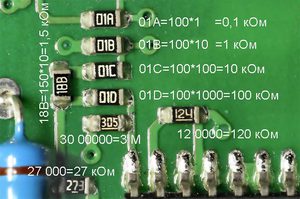 Progress does not stand still. Modern technologies are constantly being introduced, new approaches are being developed, in other words, human life is becoming more and more comfortable. In the modern world, even for calculating the resistance of SMD chipsThere are good services and programs.
Progress does not stand still. Modern technologies are constantly being introduced, new approaches are being developed, in other words, human life is becoming more and more comfortable. In the modern world, even for calculating the resistance of SMD chipsThere are good services and programs.
On the Internet, you can easily find many sites on which the opportunity to calculate the resistance. In most cases, this service is a calculator for calculating the resistance of a resistor. Here are some of them.
